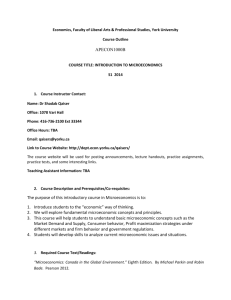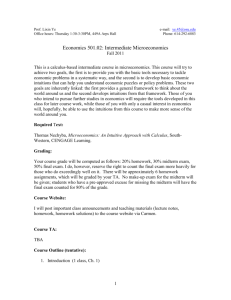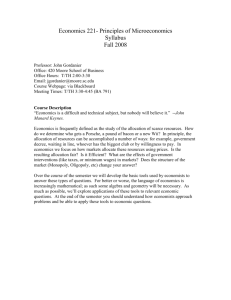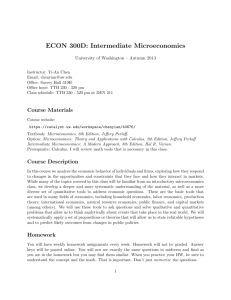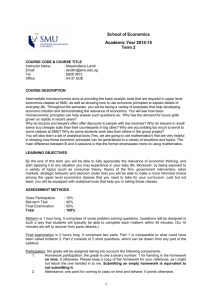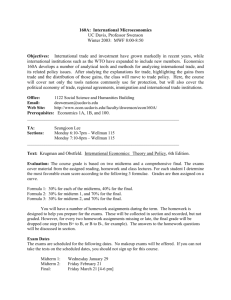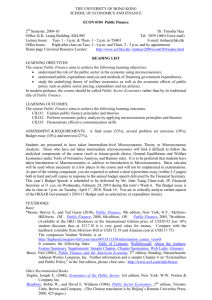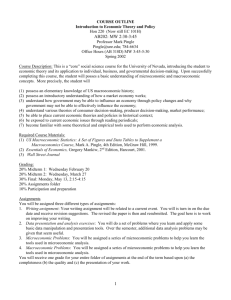Course outline
advertisement
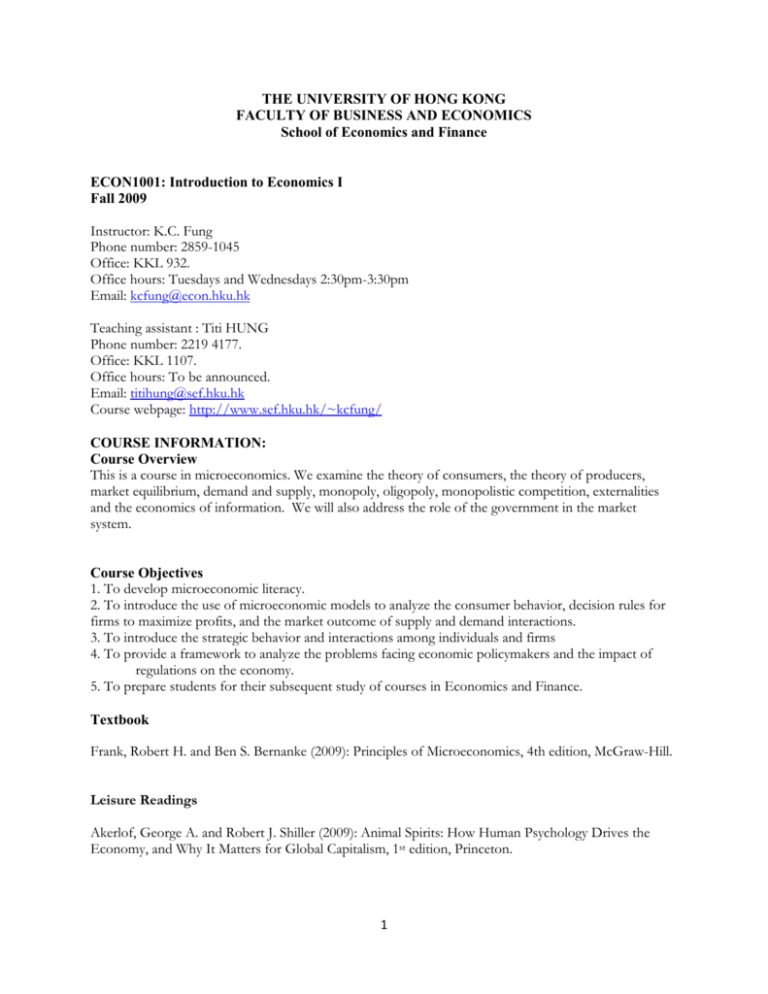
THE UNIVERSITY OF HONG KONG FACULTY OF BUSINESS AND ECONOMICS School of Economics and Finance ECON1001: Introduction to Economics I Fall 2009 Instructor: K.C. Fung Phone number: 2859-1045 Office: KKL 932. Office hours: Tuesdays and Wednesdays 2:30pm-3:30pm Email: kcfung@econ.hku.hk Teaching assistant : Titi HUNG Phone number: 2219 4177. Office: KKL 1107. Office hours: To be announced. Email: titihung@sef.hku.hk Course webpage: http://www.sef.hku.hk/~kcfung/ COURSE INFORMATION: Course Overview This is a course in microeconomics. We examine the theory of consumers, the theory of producers, market equilibrium, demand and supply, monopoly, oligopoly, monopolistic competition, externalities and the economics of information. We will also address the role of the government in the market system. Course Objectives 1. To develop microeconomic literacy. 2. To introduce the use of microeconomic models to analyze the consumer behavior, decision rules for firms to maximize profits, and the market outcome of supply and demand interactions. 3. To introduce the strategic behavior and interactions among individuals and firms 4. To provide a framework to analyze the problems facing economic policymakers and the impact of regulations on the economy. 5. To prepare students for their subsequent study of courses in Economics and Finance. Textbook Frank, Robert H. and Ben S. Bernanke (2009): Principles of Microeconomics, 4th edition, McGraw-Hill. Leisure Readings Akerlof, George A. and Robert J. Shiller (2009): Animal Spirits: How Human Psychology Drives the Economy, and Why It Matters for Global Capitalism, 1st edition, Princeton. 1 Levitt, Steven D. and Stephen Dubner (2005): Freakonomics: A Rogue Economist Explore the Hidden Side of Everything, 1st Edition, William Morrow. Stiglitz, Joseph E. (2006): making Globalization Work, Norton. INTENDED LEARNING OUTCOMES On completion of this course, students should be able to: CILO1. Explain observed decisions of firms, decisions of consumers, and outcomes related to supply and demand. CILO2. Analyze the effect of government policy on decisions of firms, decisions of consumers, market outcome and economic welfare CILO3. Understand and evaluate the economic analyses of research analysts. CILO4. Discuss and think through microeconomic issues. ALIGNMENTS OF PROGRAM AND COURSE LEARNING OUTCOMES: Program Intended Learning Objectives Course Intended Learning Objectives (CILOs) 1. Acquisition and internalization of knowledge of economics & finance CILO1, CILO2, CILO3, CILO4 2. Application and integration of knowledge CILO1, CILO2, CILO3, CILO4 3. Developing global outlook CILO1, CILO2, CILO3, CILO4 4. Mastering critical thinking skills in microeconomics CILO4 TEACHING AND LEARNING ACTIVITIES TLA1. Lectures: Instructor will give lectures on major concepts and issues. TLA2. Homework: Students will be asked to work on questions, as a review of some major concepts. TLA3. Tutorials: The TA will discuss problem sets and practice questions. Various economic issues will also be discussed. TLA4. Consultation: Both instructor and teaching assistant hold weekly consultation hours to address students’ questions. Students are also encouraged to discuss questions with the instructor and TA by email or a forum in the class website. ASSESSMENT Assessment Weight A1 Midterm #1 Midterm #2 Final exam A2 Assignments 25% 25% 40% 10% 2 Midterms: Usually lasts for one hour for midterm #1 and one and a half hours for midterm #2. Covers everything taught up to the date of test. The question paper will consist of multiple choice questions and short essay questions. The midterm exams will be held on Saturdays: students should plan to arrive five minutes early on these dates to their assigned classroom in order that the designed duration is available to them for the exam. Students arriving late will not receive compensating time: all exams must be turned in to the proctor at the end of the exam. There will be no make-up exams to replace midterms that have been missed. Students missing any midterm will receive a grade of zero for the exam unless they provide documentation of illness. Final exam: Usually lasts for two hours. Covers everything taught in the semester. Date, time and venue will be arranged centrally by the university later in the semester. Weekly Tutorials: The weekly tutorials are optional. The TAs will discuss the solutions to assignments and practice questions and will answer questions from students. Assignments: There are three essay-type assignments (usually consists of several short-answer questions) that you need to hand in and you will be given one week to finish. Late assignments will not be accepted. In addition, you will be given practice questions which you do not need to hand in. Relationship Among Intended Learning Outcome, Teaching And Learning Activities And Assessments CILO Teaching and Learning Activities (TLA) Assessments (A) CILO 1 2 3 4 TLA TLA1-4 TLA1-4 TLA1-4 TLA3 A A1&2 A1&2 A1&2 A2 STANDARDS OF ASSESSMENT We assign final grades in accordance with the following guidelines for grade distribution. Grade Performance Distribution A+, A, A- 0-25% B+, B, B- 20-50% C+, C, C- 10-50% D+, D and F Balance ACADEMIC CONDUCT The University Regulations on academic dishonesty will be strictly enforced! Please check the University 3 Statement on plagiarism on the web: http://www.hku.hk/plagiarism/ Academic dishonesty is behavior in which a deliberately fraudulent misrepresentation is employed in an attempt to gain undeserved intellectual credit, either for oneself or for another. It includes, but is not necessarily limited to, the following types of cases: a. Plagiarism - The representation of someone else’s ideas as if they are one’s own. Where the arguments, data, designs, etc., of someone else are being used in a paper, report, oral presentation, or similar academic project, this fact must be made explicitly clear by citing the appropriate references. The references must fully indicate the extent to which any parts of the project are not one’s own work. Paraphrasing of someone else's ideas is still using someone else’s ideas, and must be acknowledged. b. Unauthorized Collaboration on Out-of-Class Projects - The representation of work as solely one’s own when in fact it is the result of a joint effort. Where a candidate for a degree or other award uses the work of another person or persons without due acknowledgement: 1. The relevant Board of Examiners may impose a penalty in relation to the seriousness of the offence; 2. The relevant Board of Examiners may report the candidate to the Senate, where there is prima facie evidence of an intention to deceive and where sanctions beyond those in (1) might be invoked. CLASS SCHEDULE Week Topic 1 2 3 4 5 Thinking like an Economist (Chapter 1) Comparative advantage: the basis for exchange (Chapter 2) Supply and demand (Chapter 3) Elasticity (Chapter 4) Demand: the benefit side of the market (Chapter 5) Midterm #1 (Date: October 20, 2009, in-class, P3.) 6 7 8 9 10 Perfectly competitive supply: the cost side of the market (Chapter 6) Efficiency and exchange (Chapter 7) The quest for profit and the invisible hand (Chapter 8) Monopoly and other forms of imperfect competition (Chapter 9) Strategic choice in oligopoly, monopolistic competition, and everyday life (Chapter 10) Midterm #2 (Date: November 19, 2009, in-class, K419) 11 12 Externalities and Property Rights (Chapter 11) The Economics of Information (Chapter 12) 4
